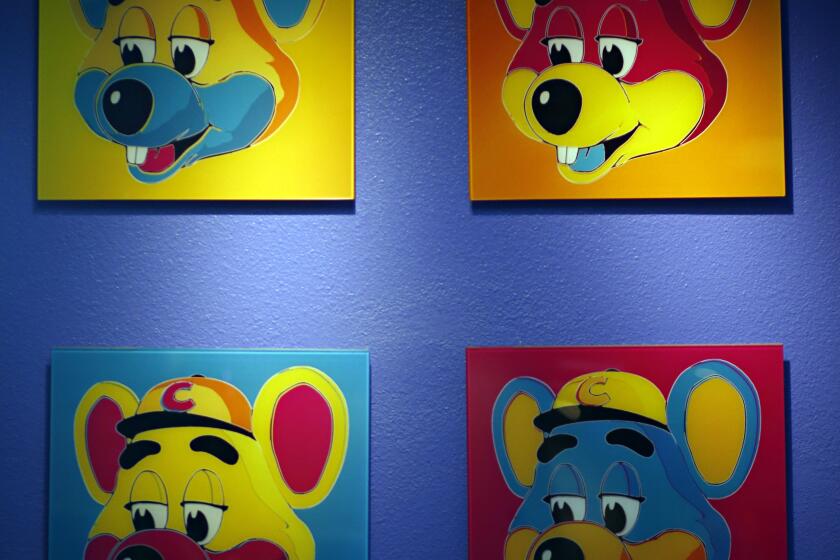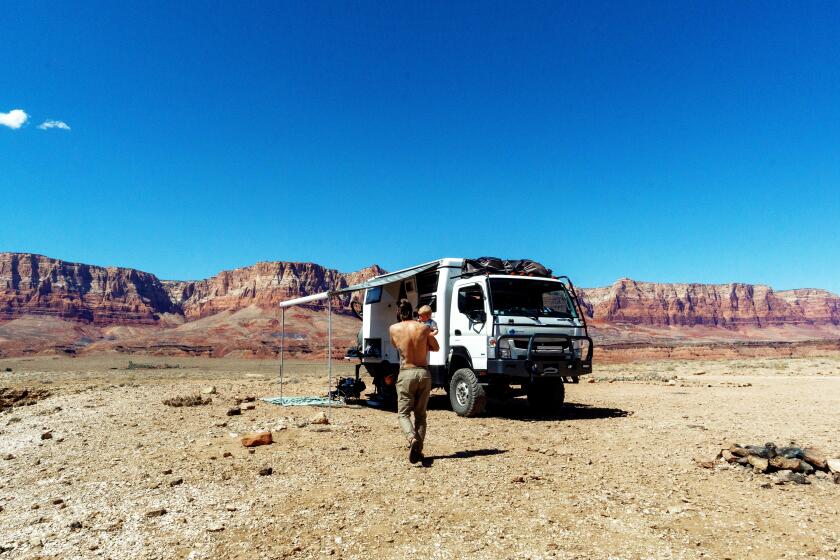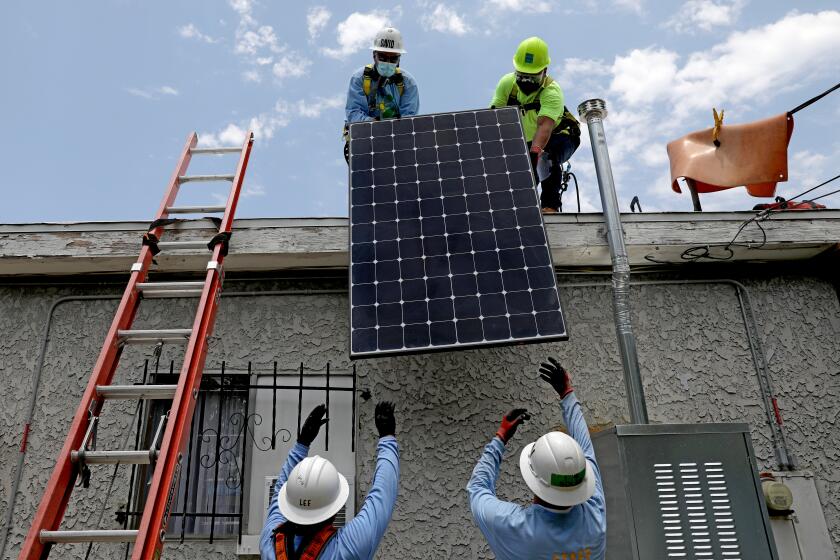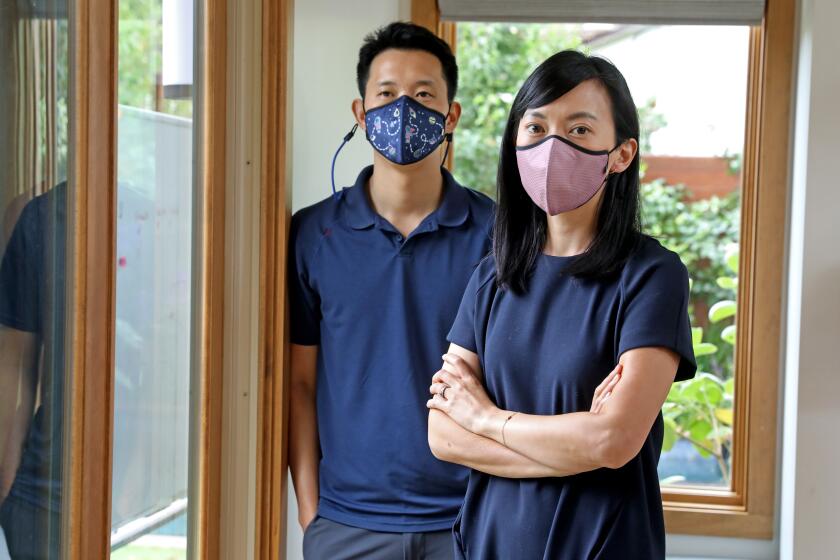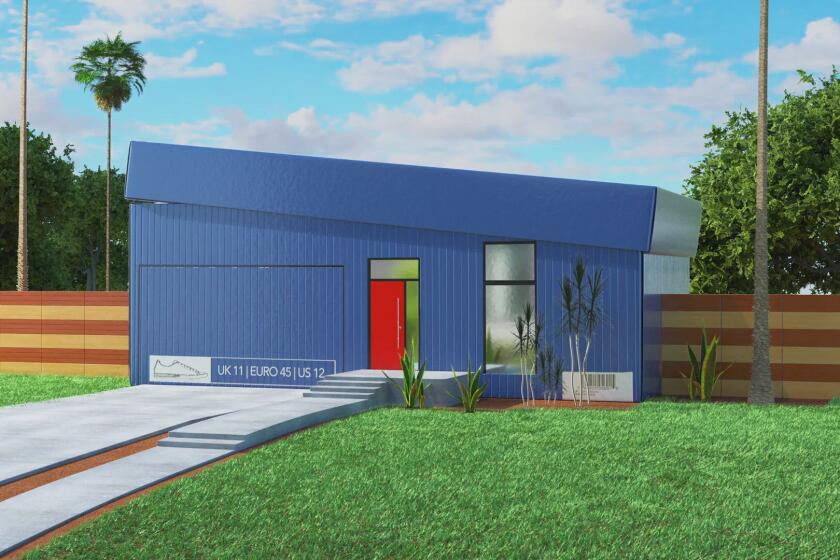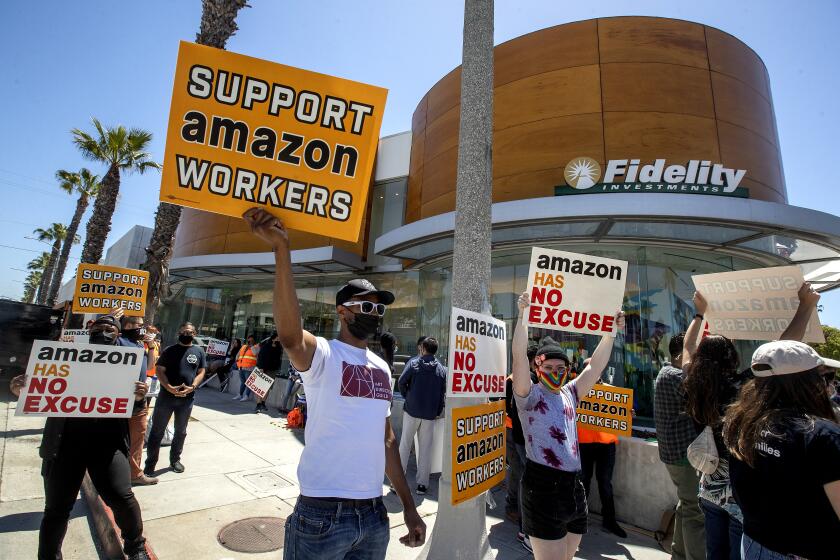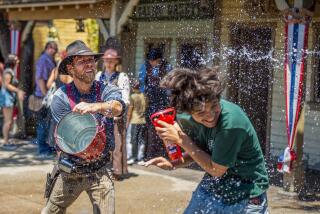Fill a room with trampolines and hope for the best? The up-and-down story of trampoline parks

It’s like a family fun center, Jerry Raymond would tell the banks. Except there are trampolines everywhere.
Trampolines as dodgeball courts, trampolines to bounce on and trampolines to launch yourself into a pit of squishy foam cubes.
“That’s the stupidest thing I’ve ever heard,” the banks and other potential funders said, according to Raymond. “But hey, have fun with that.”
It was an idea that defied conventional logic. Fill a 20,000-square-foot warehouse with trampolines and hope you attract enough paying customers to outpace rent, maintenance, payroll and insurance claims.
The premise, it turns out, proved popular and surprisingly profitable — at least until the pandemic.
Three months after Raymond and his brother Ron opened their first Sky High Sports trampoline park in 2006 in Santa Clara, they hit capacity every hour. A line of 100 customers would gather outside before the doors opened on a Saturday morning.
And those funders who scoffed at Raymond’s idea?
“Those same people, two years later, were begging to give us money,” Raymond remembers, laughing as he recounted the early days of what would become a chain that at its height had 17 locations, though the pandemic pared the business back. “We’re going, ‘Yeah, well, we don’t really need it now. Sorry.’”
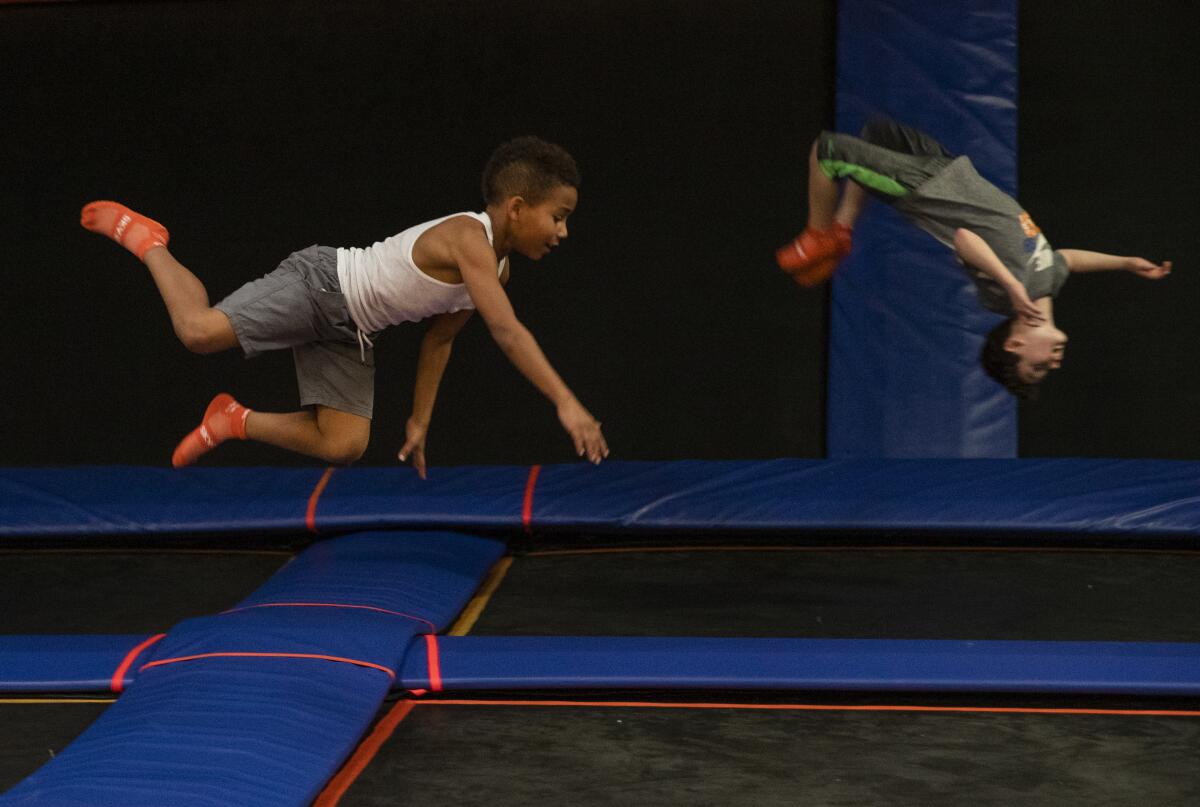
Before COVID-19, trampoline parks were popping up throughout the country, sometimes right near an existing park. They set up shop in old warehouses, former aircraft hangars, hollowed-out shells of Circuit City stores — anywhere that had space and ceilings high enough to accommodate bouncing children and the adults who accompanied them.
A monthly profit of $150,000 was not unheard of.
By 2019, the global trampoline park industry was worth $1.4 billion. It was expected to reach $3.2 billion by 2023.
Chuck E. Cheese has faced its share of struggles. But the family fun center and its well-known musical rodent have so far managed to weather changing playtime trends, gaming advancements and a pandemic that turned its arcades into ghost towns.
But the industry now faces a new reality. The pandemic whittled down the ranks of trampoline parks by more than 100 locations in the U.S. Those that survived must figure out how to bring back old customers and attract new ones while managing evolving health and safety expectations of a public scarred by COVID-19. At the same time, they must navigate the boom-and-bust cycle of children’s entertainment, in which companies such as Discovery Zone have quickly gone from hot fads to bankruptcy.
“Nobody could have anticipated what we went through the last 18 months,” Steve Yeffa, vice chair of the International Assn. of Trampoline Parks, told a small audience at the trade group’s annual convention in September in Las Vegas. “Change and adaptation, those are our constants.”
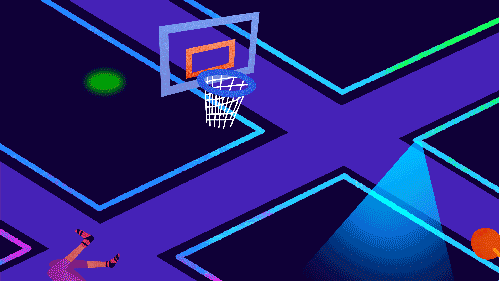
The original trampoline parks
Why do we like to bounce on trampolines?
Science tells us we crave that pleasurable feeling when fear is replaced by relief. You might be afraid to jump, but when you land safely, you want to do it again. It’s why babies love bopping around in hanging jumpers and why pools have diving boards.
“We seek out things that make us feel a little happier and exhilarated in a safe way,” said Natasha Cabrera, professor of human development at the University of Maryland in College Park.
The modern trampoline dates to 1934, when then-University of Iowa athlete George Nissen helped craft one out of strips of inner-tube rubber — an improvement on an earlier prototype devised from canvas and junkyard scraps. He gave it a test run at a YMCA summer swimming camp, and when “nobody wanted to go swimming,” he knew he was onto something, Nissen once told Reuters.
By 1959, trampolines were a craze and Southern California was a hot spot for indoor and outdoor trampoline attractions. These were not the wall-to-wall patchwork of trampolines and inflatable obstacle courses seen at today’s parks, but trampolines stretched over pits in the ground.
By March 1960, there were more than 125 in Los Angeles and Orange counties, leading The Times to declare trampolining the “heir to the hula hoops.”
Eager to escape claustrophobic pandemic life and take advantage of newly remote jobs, increasing numbers of Americans are taking to remote places in rugged vehicles that are also homes.
Melissa Rayner, president of office furniture store Trader Boys in the Sawtelle area of L.A., remembers when her father opened a trampoline center on vacant lots on Pico Boulevard, next door to his furniture store. He had an entrepreneurial mindset and was always looking for new revenue-generating opportunities, she said.
Huge spotlights shone at night to catch the attention of passersby. Customers sipped martinis before they got brave on the trampolines. Rayner recalls chipped teeth and other injuries, which weighed on her father.
“The way my dad would tell it is that’s when he developed his ulcers,” Rayner said. “He just couldn’t take it.”
Rayner’s father shut down his trampoline center around 1960, after just two years of operations.
Trampoline mania, too, was short-lived. Soon, the L.A. health department was investigating trampoline centers due to complaints about health and safety violations, leading to calls for more regulation. As injury reports piled up — including word that a San Diego high school athlete died after incurring a trampoline-related neck injury — the industry slumped.
By August 1960, a Times headline proclaimed “Trampoline Bouncing to Oblivion.” The accompanying article noted that trampoline centers were “quietly limping toward the graveyard of fads.”
“There were just too many injuries,” Dennis Speigel, chief executive of global leisure consulting firm International Theme Park Services, said of the industry slump. “Kids were getting hurt. The liabilities were just so bad that they went away.”
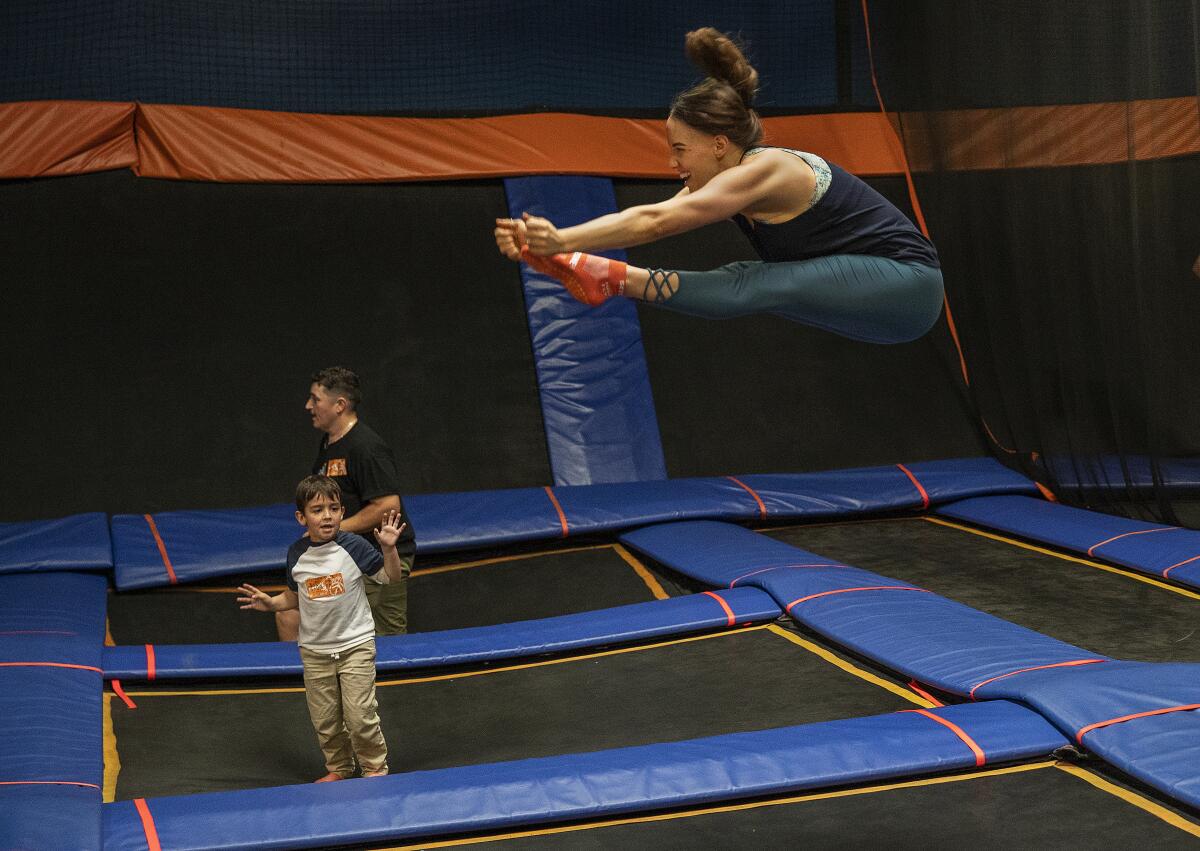
The relaunch
The story of today’s modern trampoline parks follows a path familiar to many industries — a family stumbles upon an innovative idea, grows it into a successful business that spawns a field of competitors, faces internal strife and then, eventually, gets swallowed up by a big private equity-backed firm.
It all started, however, with a professional sport you’ve never heard of.
Sky Zone was patented first as a competitive sport in 1997 by inventor Karin-Maria K. Winkelhorn. According to the patent, the sport would be played on rectangular “trampoline-like channels” connected by cables, with padding on the edges. A few years later, entrepreneur Rick Platt bought the patent and started recruiting trampolinists, gymnasts and others daring enough to take part.
It made its debut around 2003 with an exhibition game at the Orleans Arena in Las Vegas.
“It was such a fast-action sport,” said Raymond, who was then the owner of a computer consulting company and attended the exhibition game in person after seeing TV ads. “The acrobatics of it, the physical acumen of the players, I just thought it looked really unusual and really fun.”
It was, indeed, unusual. Promotional footage of the game shows players outfitted in helmets and shoulder pads flipping and bouncing off walls, tackling each other and “rouncing” (the term used by Platt to describe the combination of running and bouncing on the trampolines). Players rack up points when they hurl the ball — or themselves — through a hoop. (“The player becomes the ball,” the promotional video proclaims.)
The idea didn’t catch on.
Clean energy activists and utility giants are duking it out over the future of rooftop solar.
But when kids from a nearby skate park started hopping on the trampolines at the company’s Las Vegas research-and-development center, Platt saw another path. Sky Zone opened for business in 2004 in the same facility. Two years later, Sky Zone opened a second location in St. Louis, where Platt’s son, Jeff, was finishing up college and could oversee the business.
“Most people said to us, ‘The success of your first location was due to the fact that it’s in Las Vegas, and people in Las Vegas like crazy things. Therefore, it doesn’t really mean anything that it’s doing well there,’” Jeff Platt said. “And so we said, ‘OK, we’ll try and do well in St. Louis.’”
A month later, his mother was diagnosed with cancer, and his father stepped back from the business. The then-21-year-old was in charge.
Over the next 15 years, he expanded Sky Zone into a chain of more than 150 trampoline parks around the globe, many of which are franchised. In 2016, Sky Zone was ranked No. 2 on trade publication Franchise Times’ list of fastest-growing franchises with staying power. In 2019, the parks had a total of 30 million visitors and $380 million in total revenue. (The company, which is based in Los Angeles, declined to comment on 2020 revenue and how the pandemic affected its business.)
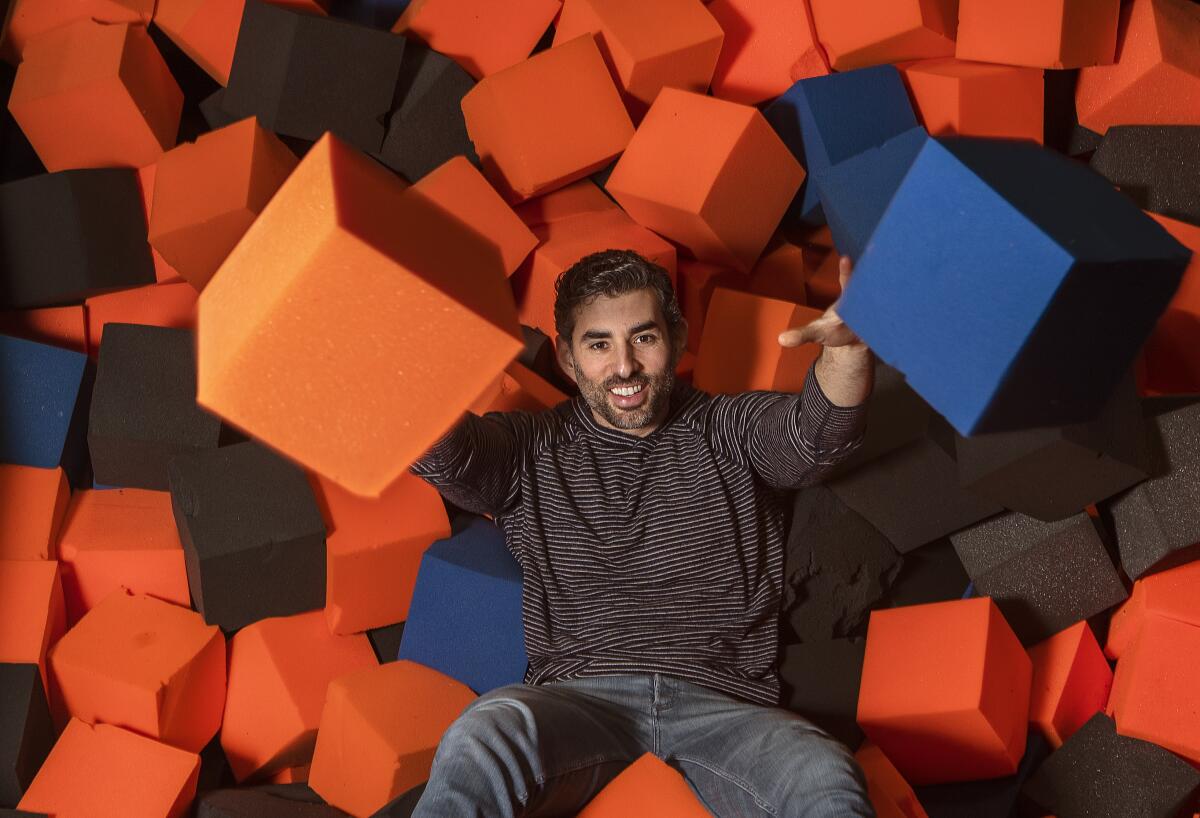
As the company grew, its leadership team started to fracture.
In 2014, founder Rick Platt sued Sky Zone, its subsidiaries, his son Jeff and other Sky Zone executives, alleging that they unjustly pushed him out of the company. In court documents, Jeff Platt argued that his father was disrupting daily operations and management and that his actions “frustrated efforts” to look into a “long-discussed potential sale.”
In 2016, an arbitrator ruled that Rick Platt had been properly removed from Sky Zone.
“Shareholders and partners sometimes don’t get along,” Jeff Platt said. “No lawsuit is a positive thing on anybody, especially when it involves family. But the good news is we’ve been able to completely move on from it.”
Rick Platt said he didn’t agree with the arbitration decision, but didn’t want to dispute it and prolong the dispute. He doesn’t blame his son for the managers’ actions.
Then came an acquisition. In 2018, CircusTrix, a Utah-based park operator, bought the company. It owns several other trampoline park chains and is backed by Palladium Equity Partners, a private equity firm that’s invested in a variety of businesses, including Daniel’s Jewelers, mental healthcare provider Health Connect America and Del Real Foods. The terms of the deal were not disclosed. In October, Jeff Platt said via LinkedIn message he was no longer involved at the company or in the industry.

How the business works and doesn’t
Here’s the business model: Kids — er, parents — pay at the door, between $25 and $30, on average, for two hours. Once inside, there’s all manner of attractions: trampolines, American Ninja Warrior-esque obstacle courses, rope courses, rock climbing walls, basketball hoops above bouncy floors from which anybody can leap and, hopefully, dunk.
The dress code is a pair of socks with grips on the bottom, typically brightly colored and often branded with a park name or logo. The rubberized grips keep people from slipping and help ensure the parks stay clean. At Urban Air Adventure Park, they cost $2.99.
Aside from entry fees, birthday parties are the main revenue driver — at Urban Air, they make up about 30% of the park’s business. The rest of the pie is food and beverage sales (about 15% to 20%) and retail sales, such as hats, T-shirts and those mandatory socks (5% to 10%).
It can be seasonal — summer months get busy, but parks also thrive in inclement weather.
Among the biggest challenges is the intrinsic risk in a business whose customers test the limits of gravity. Mitigating it was a key topic at the trampoline park trade group’s recent convention in Las Vegas. Industry insiders analyzed examples of parks’ signs listing rules and guest responsibilities (avoid starting with “don’t,” because that will give people ideas about the exact kinds of things they shouldn’t be doing).
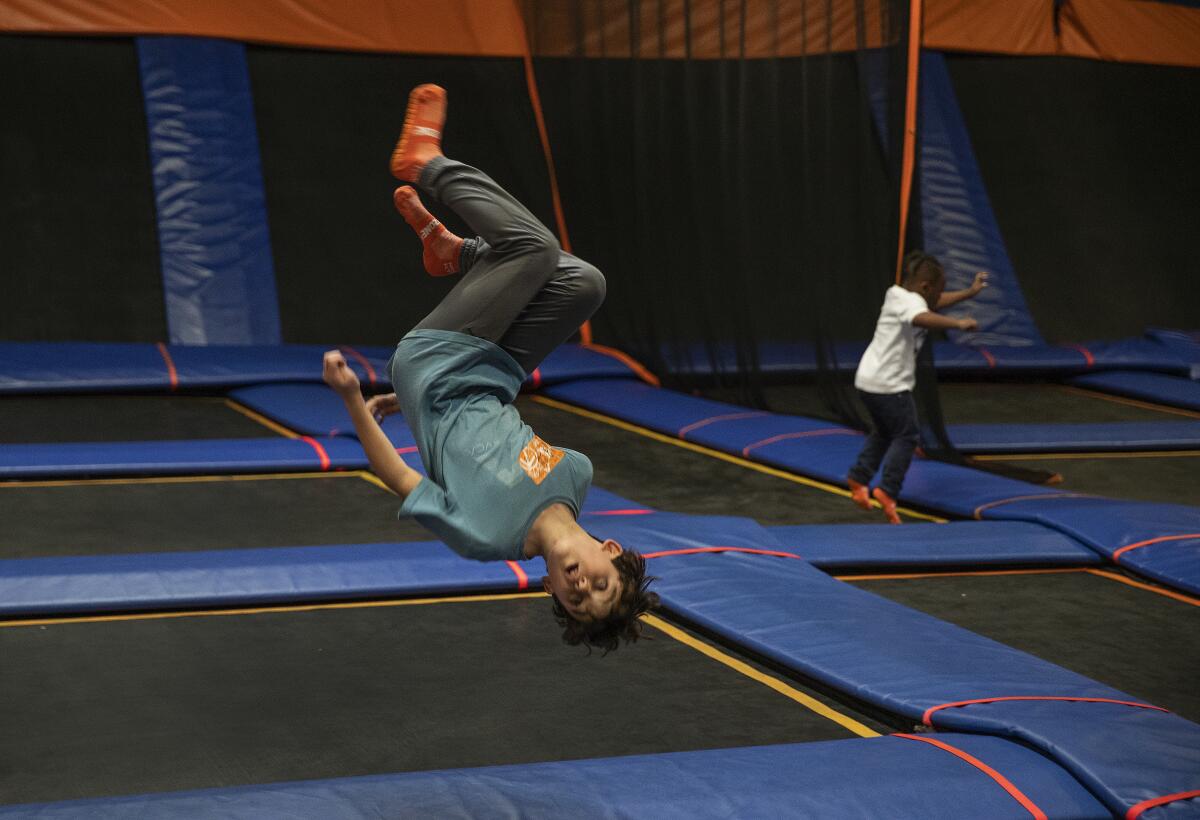
But there’s no way to entirely remove the possibility of injury.
Trampoline parks are fun, but they are “inherently unsafe,” said Dr. Steven Rogers, coauthor of a 2016 study on trampoline park injuries and an injury prevention research scientist at the Injury Prevention Center at Connecticut Children’s.
His own children have gone to trampoline parks, but each time he reinforced the ground rules: safe distancing and no flips.
The study he co-wrote found that emergency room visits for trampoline park injuries increased significantly from 2010 to 2014, just as the industry was gaining steam. During that same time period, emergency room visits for home trampoline injuries stayed the same.
The most common trampoline park injuries are shoulder and neck sprains.
The study, published in the journal Pediatrics, concluded that improving padding around the trampoline frames and restricting flips would reduce potential risk of injury, he said.
“It’s a matter of finding that balance between fun and safe,” Rogers said. “We have to really monitor … our kids to make sure they’re acting safe while they’re there.”
Happy Masks’ face coverings for kids are a back-to-school sensation amid heightened COVID-19 anxiety — but good luck buying one.
There’s no comprehensive database of fatalities or serious injuries at parks. A CBS News report identified six fatalities from trampoline park injuries, and headlines from around the country chronicle serious injuries.
A scan of lawsuits against Southern California trampoline parks shows all manner of alleged injuries — a person who sat in a defective chair, another falling down after an unsupervised child jumped on the same section of the trampoline, and someone who “suffered a bilateral quadricep tendon rupture after being encouraged by defendants’ advertisement for patrons to ‘dunk like a pro’ with its 10-foot basketball rim on top of a trampoline bed.”
Customers sign waivers, which can limit a park operator’s liability. But whether they provide full indemnity varies case by case, state by state, and fine print by fine print.
Industry leaders worked early on to establish rules, setting their own benchmarks for safe facilities. They gathered in 2012 at House of Air in San Francisco and spent two days arguing over the minimum standards for trampolines — the types of fabric permissible, the length of the springs to make sure people don’t bounce too high, the heights of the trampolines themselves and the ceilings above them.
The big battle was over standards for foam pit construction, which some owners had already installed in their parks. House of Air co-founder Dave Schaeffer remembers drawing on a whiteboard proposed construction specs as rival park operators debated the measurements.
“Everybody in that room was a competitor of everyone else in the room,” he said. “But we were all there to do the right thing and build a safety standard for the industry to give us all a future.”
The ratified safety guidelines, known as ASTM standards, gave insurance companies a bar all parks had to live up to to get insured. And the only way to have any sort of longevity in this industry is to have excellent insurance, Schaeffer said.
The idea was simple: Nile Niami would build and sell The One, the biggest and most extravagant new home in the country. Then things went sideways.
Insurance premiums, including coverage for general liability, property insurance, workers’ compensation and the like, can eat up 4.5% to 6% of park revenue, said Doug Flora, director of program for Haas & Wilkerson Insurance and the insurance program manager for the International Assn. of Trampoline Parks. The general market for amusement and leisure segments has lower overall premiums in the range of 3% to 4.5%.
Flora said his firm has seen a “very low frequency of claims” in the trampoline park segment of its business compared with its overall portfolio, which includes amusement parks, water parks, carnivals and fairs.
Recently, the market for trampoline park insurance has become a bit tighter after one provider dropped out, leaving just four providers and Lloyd’s, the insurance of last resort.
Bouncing back from COVID-19
In January 2020, Urban Air founder Michael Browning began to hear from his global suppliers in Nanjing, China, about a rapidly-spreading virus that was sickening their workers. The indoor chain started to make contingency plans and by March 3, Browning laid out to the firm’s board of directors how they would protect operators and guests. He hoped he’d never have to use it.
“There was no playbook for COVID when it happened,” said Browning, who is now CEO of Unleashed Brands, a platform company whose portfolio includes Urban Air. “You couldn’t look to 9/11, you couldn’t look to a housing crisis. Those things didn’t compute.”
Like other nonessential businesses, trampoline parks across the country shut down as COVID-19 spread. Some parks faced a few months of closures, others much longer. House of Air in San Francisco was closed for 14 months.
“It was brutal, it is brutal, it’s still brutal,” House of Air co-founder Schaeffer sighed. “The only reason we’re still around is because of the PPP program.”
Others weren’t so lucky. The entire chain of Sky High parks closed, with some sold to competitors.
COVID-19 unleashed new demand for homes, made the well-off wealthier, and fueled extreme bidding wars. The result? The $1-million home is everywhere.
As the pandemic began to wane ever so slightly, park operators wondered: Would trampoline enthusiasts — and, in many cases, their parents — come back as they did before indoor recreation became anathema?
For parks such as Urban Air, the answer was yes.
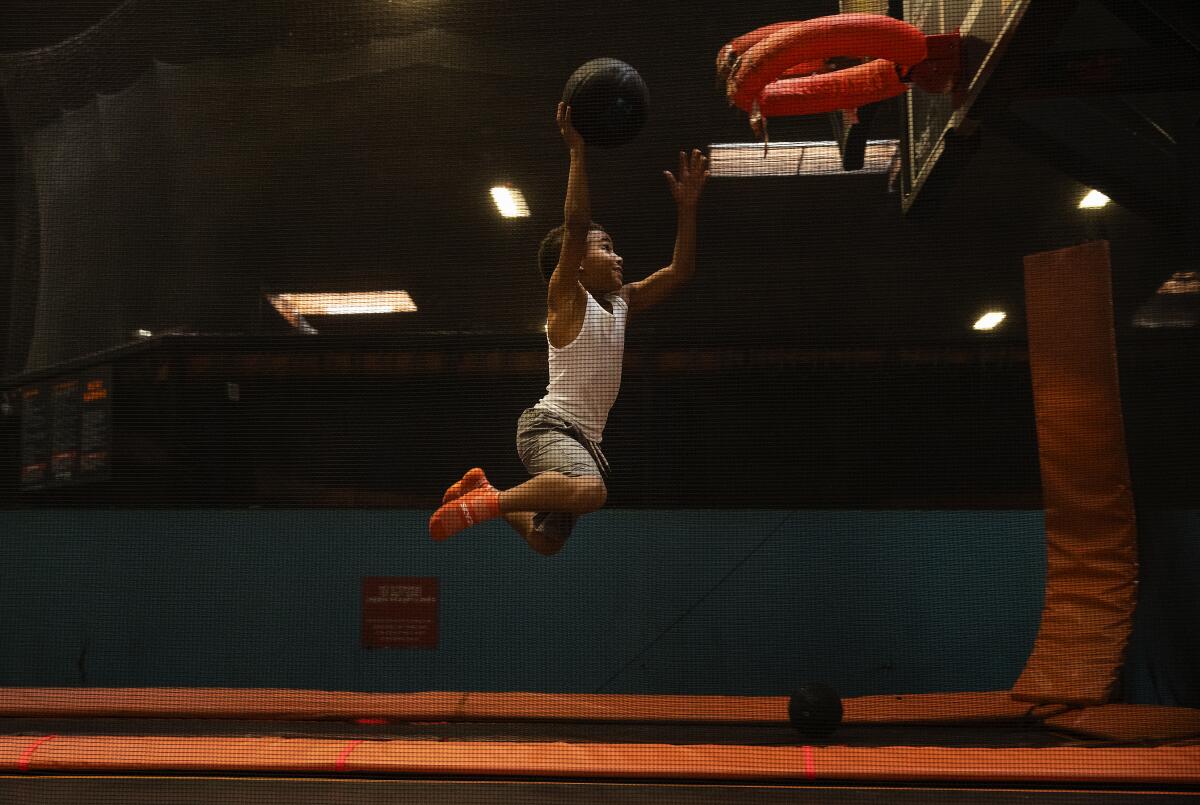
Same-store sales were up seven months in a row from March to September compared with 2019, said Jay Thomas, brand president and CEO of Urban Air. The company “turned the corner” in March and then saw a strong spring and summer. July was a “record-breaking revenue month for us across the board,” he said.
“During the pandemic, I think it became very obvious that people really needed a way to connect,” Thomas said. “They wanted it to be a real connection with people, and I think that our guests have embraced this.”
There have been some changes. Equipment at Urban Air parks is regularly sanitized with an antimicrobial spray that Thomas says is used in hospitals, and guests are encouraged to wash their hands regularly with a song that plays on the speakers every 30 minutes, while staff members wipe down attractions.
In the industry more generally, parks are moving toward giant airbags for guests to hurl themselves onto rather than foam pits, which are harder to clean and need to be frequently replaced. It was a trend that was already occurring before the pandemic, particularly because of injury concerns, but is now marketed as an easier way to keep parks sanitized.
The new normal
Tara Liloia didn’t expect much of her first visit to a trampoline park: sort of like a mini-golf course, or one of those sad family fun centers of yesteryear. To her surprise, the Seattle park where she and her son attended a birthday party was clean and fun.
Her family now has a membership at Defy trampoline park in Thousand Oaks, which they frequent at least two to three times a month. They have collected so many rubber-grip socks that they keep spares in the car so they can jet to the park whenever the urge strikes.
“There’s just this freedom to jumping that he really enjoys,” said Liloia, 46, a novelist and screenwriter who lives in Westlake Village. “He can do these little daredevil tricks in a controlled environment that he couldn’t do at home.”
While trampoline parks are eager to retain loyal customers such as Liloia and her 12-year-old son, they’ve also increasingly had to branch out to others for whom bouncing has grown passé.
AB 701, headed to a Senate vote this week, is the first legislation in the U.S. that would regulate warehouse performance metrics.
That’s led to some diversification at trampoline parks. Or as one former executive put it, “there’s very little trampoline going on at trampoline parks.”
It’s a lesson that doomed children’s play place business Discovery Zone and other long-ago giants of the family fun center trade. How do you stay relevant when so many other activities are fighting for children’s attention and parents’ dollars?
At the annual industry convention, there were the expected vendors — high-performance trampoline manufacturers and a company called Big Airbag. But mixed among the tables laden with durable fabric samples and mannequin feet modeling rubber-grip socks were at least three different laser tag vendors, arcade game sellers and one booth selling what it calls the world’s first catch-and-hold auto belay, a system used for indoor rock climbing.
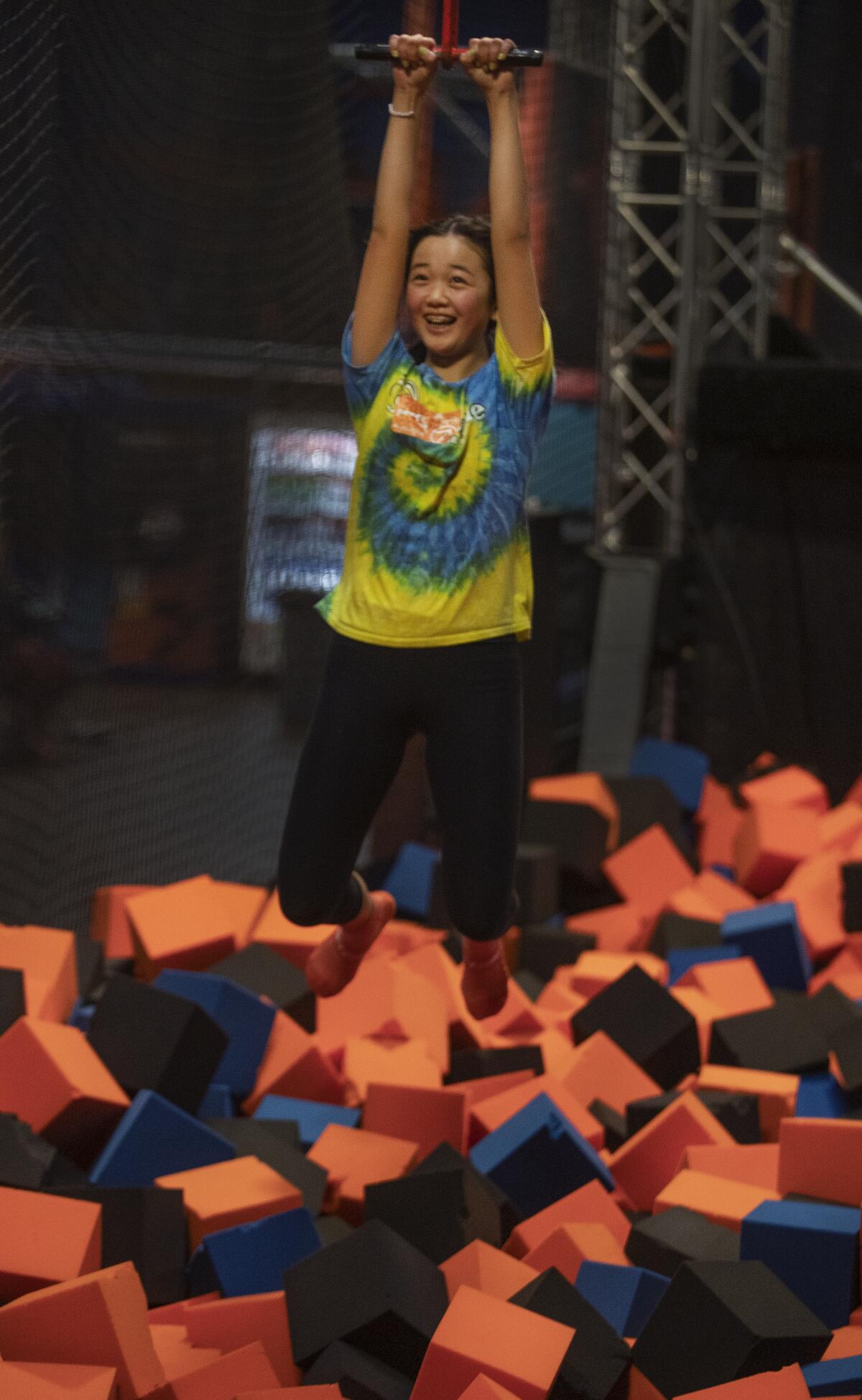
Some parks are being converted into clubs on the weekend. Others are adding rock climbing walls or go-karts. Along with kids’ birthday parties, they hope to court corporate retreats and charitable outings.
“It isn’t any longer just for that traditional mom who comes with kids,” said Swathi Ravichandran, director of Bowling Green State University’s resort and attraction management program. “It’s also for adults, it’s for all of these new usage occasions.”
Trampoline parks aren’t only competing against each other; they’re competing against anywhere that discretionary dollars are spent, including large theme parks, family entertainment centers and the like.
That means they’re starting to look less and less like pure trampoline parks. When Urban Air began in 2011, 85% of its parks’ floor space was dedicated to trampolines. Today, it’s no more than 20%.
“We’re competing in an environment where there’s a number of people who have really great attractions to offer,” said Thomas of Urban Air. “We make sure we have the most innovative attractions and package them together.”
But in a much smaller, some would say right-sized industry, the landscape for bouncing is going to look different. The years of skyrocketing growth probably are long gone. The days of new parks opening at every mall or suburban office park are finished.
Those parks that remain will have to let go, somewhat, of the past. Trends evolve, emerge and sometimes remain elusive until it’s too late.
What is the next trampoline park? The next activity that captures children’s attention? Schaeffer of House of Air says he hasn’t seen it yet.
After all, jumping on a trampoline defies the rules of gravity. You’re flying like a bird for just a moment, he says. What can compete with that?
More to Read
Inside the business of entertainment
The Wide Shot brings you news, analysis and insights on everything from streaming wars to production — and what it all means for the future.
You may occasionally receive promotional content from the Los Angeles Times.
